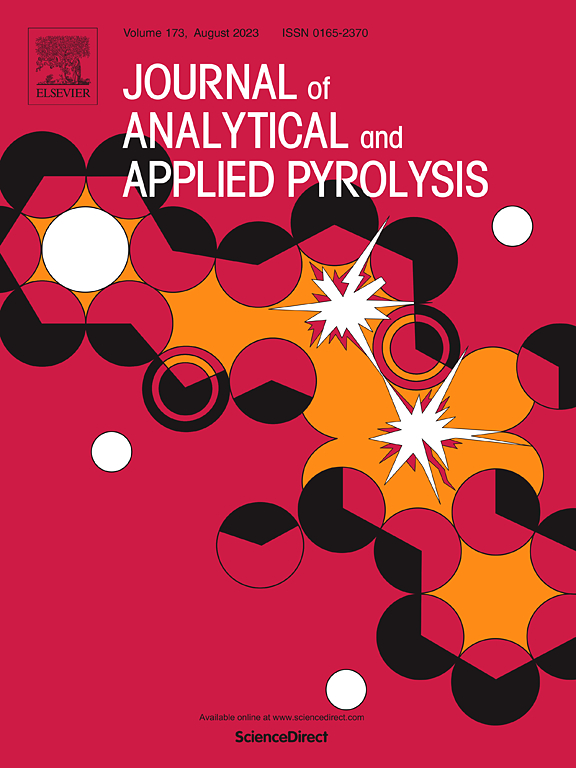Preparation of metal-modified carbon-based catalyst and experimental study on catalytic pyrolysis of distillers dried grains with solubles
IF 5.8
2区 化学
Q1 CHEMISTRY, ANALYTICAL
引用次数: 0
Abstract
Distillers dried grains with solubles (DDGS) offer high calorific value, suited for catalytic rapid pyrolysis for energy and chemical applications, yet tar and coke formation during bio-oil upgrading necessitates exploration of cost-effective, durable biocarbon-based catalysts for tar removal. In this study, a carbon-based catalyst was prepared by metal modification of alkaline biochar for catalytic pyrolysis with Distillers dried grains with solubles (DDGS) biomass. Brunauer–Emmet–Teller (BET), X-ray diffraction (XRD), Fourier Transform Infrared (FTIR) were used to characterized the morphology and microstructure of the metal-modified carbon-based catalysts. Pyrolysis-gas chromatography/mass spectrometry (Py-GC/MS) was used to analysis the pyrolysis-gas of catalytic pyrolysis. Furthermore, the effects of the loading and metal mass ratio of carbon-based monometallic catalysts (Fe and Co) and carbon-based bimetallic catalysts (Fe-Co) on the distribution of the DDGS pyrolysis products were further investigated. The results showed that the 8 wt% of loading rate of bimetallic catalyst significantly reduced the oxygenated compounds but increased the aromatic hydrocarbons. Compared with pyrolysis without catalyst, when the catalyst was 2Fe6Co (mass ratio of Fe/Co 1:3), the hydrocarbons increased from 36.42 % to 44.53 %, the oxygen-containing compounds decreased from 60.36 % to 52.35 %, and the aromatics increased significantly from 0.73 % to 25.37 %. This study provides a new route of increasing the aromatic hydrocarbon content of catalytic pyrolysis to offer theoretical basis for carbon-based catalysts of biomass conversion.
金属改性碳基催化剂的制备及其催化热解蒸馏酒糟的实验研究
带淀粉的蒸馏干谷物(DDGS)热值高,适合用于能源和化学应用的催化快速热解,但在生物油升级过程中会形成焦油和焦炭,因此有必要探索具有成本效益、经久耐用的生物碳基催化剂来去除焦油。在本研究中,通过对碱性生物炭进行金属改性,制备了一种碳基催化剂,用于催化热解蒸馏干粮(DDGS)生物质。利用布鲁纳-艾美特-泰勒(BET)、X 射线衍射(XRD)和傅立叶变换红外(FTIR)对金属改性碳基催化剂的形态和微观结构进行了表征。热解气体色谱/质谱法(Py-GC/MS)用于分析催化热解的热解气体。此外,还进一步研究了碳基单金属催化剂(Fe 和 Co)和碳基双金属催化剂(Fe-Co)的负载量和金属质量比对 DDGS 高温分解产物分布的影响。结果表明,双金属催化剂的负载率为 8 wt%时,含氧化合物显著减少,但芳香烃增加。与不使用催化剂的热解相比,当催化剂为 2Fe6Co(Fe/Co 的质量比为 1:3)时,烃类从 36.42% 增加到 44.53%,含氧化合物从 60.36% 减少到 52.35%,芳烃从 0.73% 显著增加到 25.37%。这项研究为提高催化热解的芳香烃含量提供了一条新途径,为生物质转化的碳基催化剂提供了理论依据。
本文章由计算机程序翻译,如有差异,请以英文原文为准。
求助全文
约1分钟内获得全文
求助全文
来源期刊
CiteScore
9.10
自引率
11.70%
发文量
340
审稿时长
44 days
期刊介绍:
The Journal of Analytical and Applied Pyrolysis (JAAP) is devoted to the publication of papers dealing with innovative applications of pyrolysis processes, the characterization of products related to pyrolysis reactions, and investigations of reaction mechanism. To be considered by JAAP, a manuscript should present significant progress in these topics. The novelty must be satisfactorily argued in the cover letter. A manuscript with a cover letter to the editor not addressing the novelty is likely to be rejected without review.

 求助内容:
求助内容: 应助结果提醒方式:
应助结果提醒方式:


